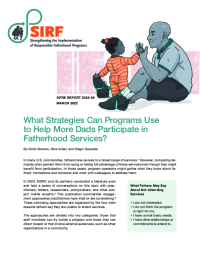What Strategies Can Programs Use to Help More Dads Participate in Fatherhood Services?

 Introduction
Introduction
In many American communities, fathers have access to a broad range of services. However, competing demands often prevent them using or from taking full advantage of these services. In those cases, program operators might gather what they know about fathers’ motivations and concerns and work with colleagues to address those motivations and concerns.
In 2020, MDRC and its partners conducted a literature review and held a series of conversations on this subject with practitioners, fathers, researchers, policymakers, and other stakeholders. This publication collects engagement approaches practitioners and other stakeholders have tried or are considering. These promising approaches are organized as responses to challenges fathers often share about why they are unable to attend services:
- I am not interested.
- I do not think the program is right for me.
- I have unmet basic needs.
- I have other relationships or commitments to tend to.
Purpose
Responsible Fatherhood programs work with fathers to promote healthy relationships, improve parenting skills, and help fathers attain economic stability. For programs to improve fathers’ outcomes, they need to be able to recruit fathers, engage them in services, and keep them actively participating in program activities. This brief describes promising approaches to address barriers to participation that affect a wide variety of programs.
Methods
Beginning in January 2020, the study team sought to learn about the challenges faced by fatherhood programs and promising approaches for addressing those challenges. The team emailed and talked by phone with nearly 100 individuals including 29 federal staff members across different agencies, 5 staff members from state agencies, 4 developers of curricula designed to be used with fathers, 4 individuals from nonprofit funding organizations, 8 training and technical assistance providers, 14 researchers including experts in iterative learning methods and program evaluation, and 30 program staff members at fatherhood programs.
The approaches in this brief are divided into two categories: those to try inside a program and those to direct toward external audiences and organizations.
Recommendations
“I am not interested”
- Train staff members to address their biases related to racial and gender stereotypes, young parents, and involvement in the justice system.
- Provide messages about the role of a father and its intersection with other roles men have.
- Spend time at places in the community where fathers congregate, like barbershops.
“I do not think the program is right for me”
- Integrate services or change their order; for example, offer employment classes before parenting classes.
- Locate services at places fathers already visit (for example, a military base or community college).
- Try different orders and intensities of services to find what works best.
“I have unmet basic needs”
- Connect fathers to workforce development services and nonprofit providers.
- Do mock job interviews with questions on involvement in the justice system.
- Frame incentives or program support as help to offset expenses.
“I have other relationships or commitments to tend to”
- Have a policy for make-up sessions and excused absences.
- Create a separate program for mothers or include them in services.
- Offer childcare or a kid activity.






